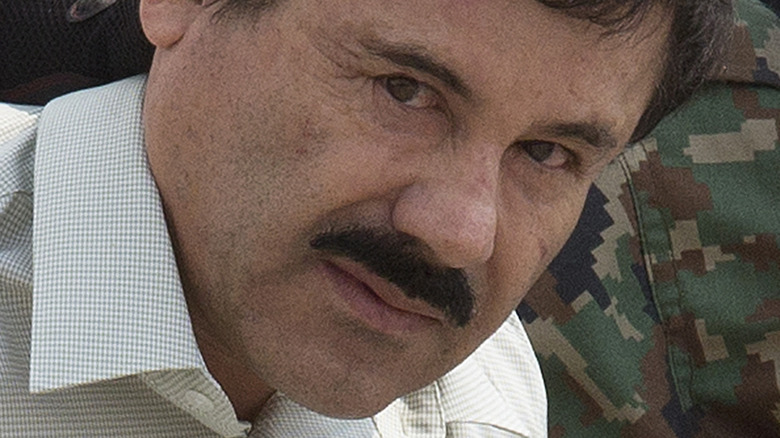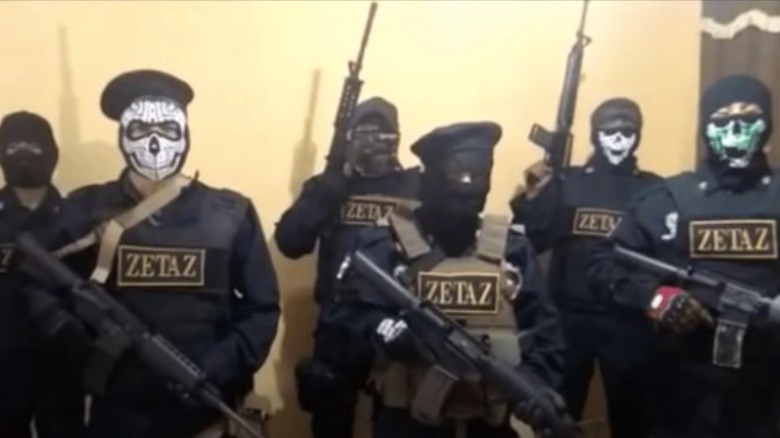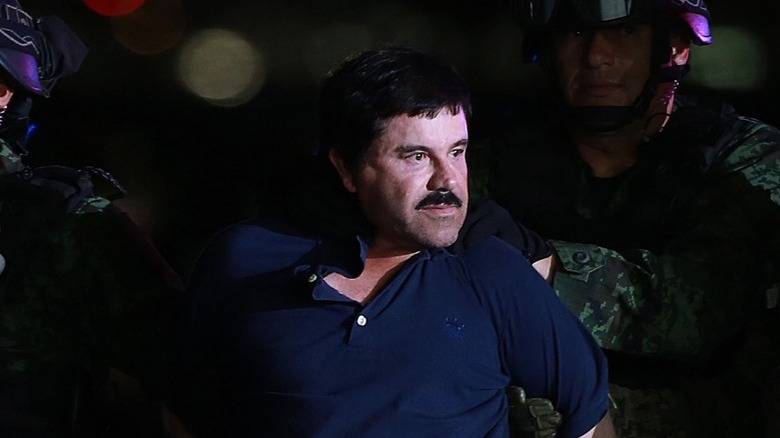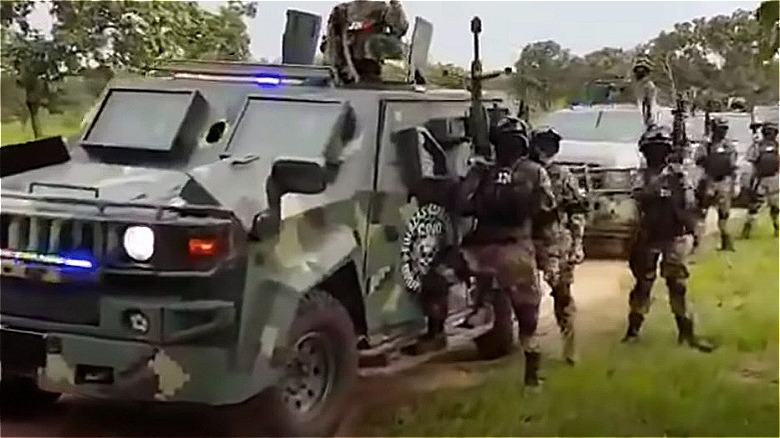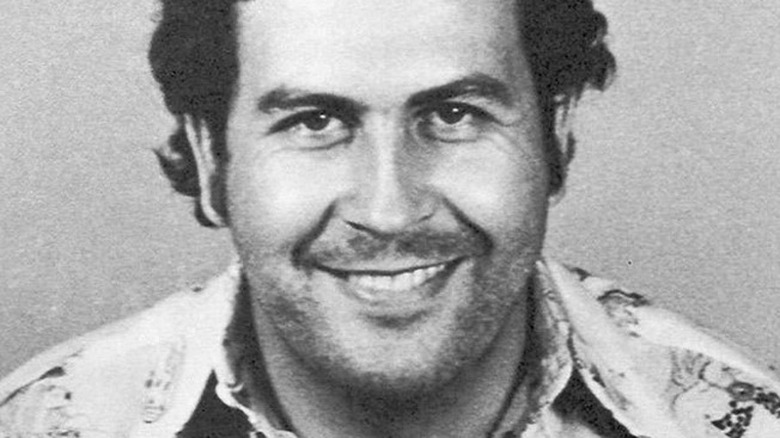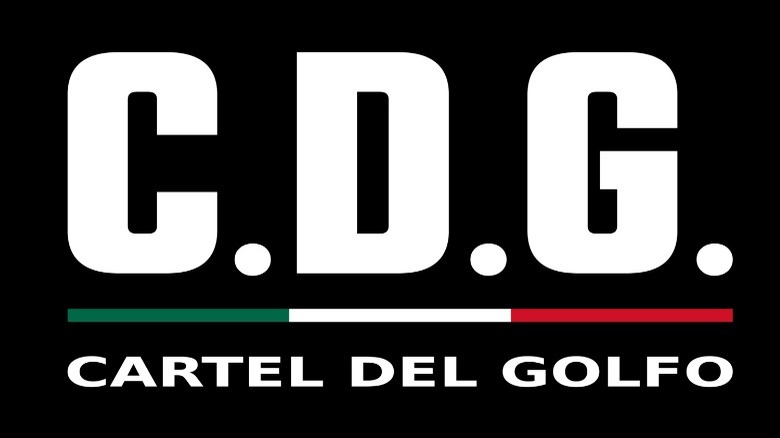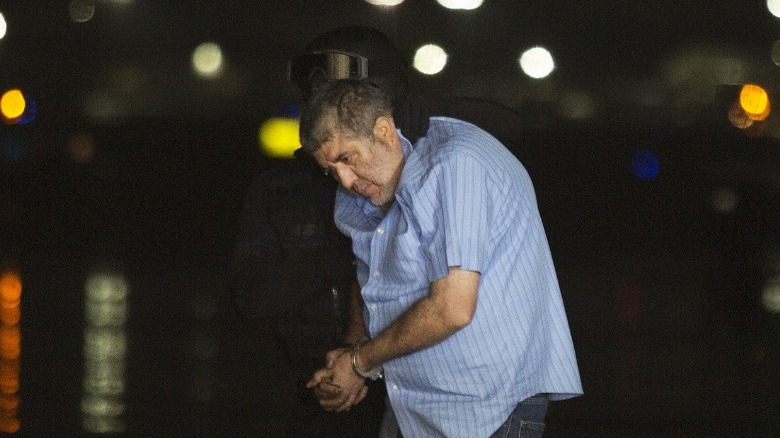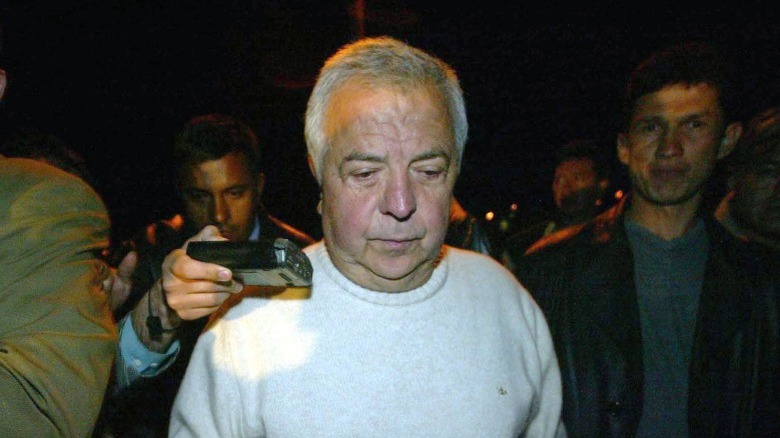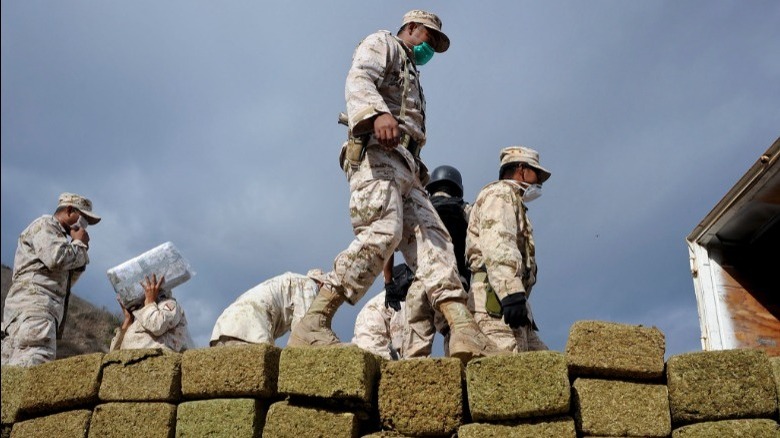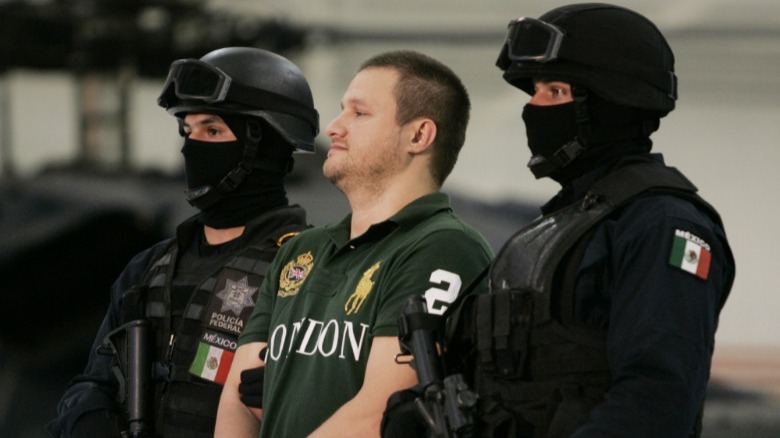The Most Dangerous Cartels To Ever Exist
Cartels have dominated the international drugs trade since the 1980s, earning many billions of dollars and killing tens of thousands of people in Mexico and Colombia alone (via Al Jazeera and Britannica).
Britannica writer Richard J. Samuels defines cartels as, "An illicit consortium of independent organizations formed to limit competition and control the production and distribution of illegal drugs," adding that cartels are, "extremely well-organized, well-financed, efficient, and ruthless." Similarly, the U.S. Department of Justice defines cartels as, "large, highly sophisticated organizations composed of multiple drug trafficking organizations (DTOs) and cells with specific assignments such as drug transportation, security/enforcement, or money laundering."
However, despite the logistical sophistication and the massive financial success, the history of cartels is fraught with betrayal, splinter groups, and brutally shortened lives. And these lives are often innocent civilians caught up in the dreadful violence and corruption, such as the shootout in Tulum, which killed two tourists and injured three more, according to The Guardian. According to reports in the BBC and Insight Crime, the latest cartel trend is the fragmentation of the drug trafficking landscape, especially in Mexico. This has led to savage fighting between some 400 splinter gangs, each killing and maiming for scraps of territory (via Business Insider). Consequently, several Mexican cities — such as Los Cabos, Tijuana, and Acapulco — have recorded some of the highest murder rates in the world, according to Statista. With that grim context in mind, here are the most dangerous cartels to ever exist.
Los Zetas
Los Zetas is a powerful Mexican drug cartel that has made special use of fear to achieve its business goals. Rather than prioritizing corruption like its competitors, Los Zetas has preferred to use paramilitary violence to seize territory and intimidate rivals, according to Insight Crime. Los Zetas was formed in 1997 to serve as enforcers for the Gulf Cartel. Initially, the group was led by Osiel Cárdenas Guillén, who recruited around 30 alumni from Mexico's special forces. During their enforcer period, the US Drug Enforcement Agency (DEA) described Los Zetas as perhaps "the most technologically advanced, sophisticated and violent of these paramilitary enforcement groups."
In 2010, Los Zetas established itself on its own terms, terrorizing the country with torture, beheadings and massacres (via Irish Times/Britannica). In this pivotal year, Zetas occupied territory in 405 Mexican municipalities, which Insight Crime found was more than double that of their biggest rivals. As the cartel made connections across Mexico and the world, their death toll increased exponentially. In August 2010, Zetas executed 72 migrants in Tamaulipas, which was followed by 2011 attacks in San Fernando and a Monterrey casino, killing a combined 245 people. Months after the casino attack, 49 decapitated bodies were dumped on a Monterrey highway (via Insight Crime/The World).
However, despite their swift and brutal success, Insight Crime reports that Los Zetas has experienced fragmentation since 2012, especially when the Trevino brothers fell out and split the group into rival clans, the Northeast Cartel and the Zetas Old School.
Sinaloa Cartel
Based in northwest Mexico's Sinaloa state, the Sinaloa Cartel is widely considered to be the most powerful drug trafficking organization in the Western Hemisphere, according to Insight Crime. The cartel can trace its roots to the 1960s and '70s, when farming families entered the marijuana business. Among these provincial traders and smugglers was Joaquín Guzmán Loera, better known as "El Chapo."
During the late '70s and 1980s, the Sinaloa Cartel worked with the Medellin cartel, establishing lucrative cocaine routes to the United States that spanned land, sea and air. After the group's 1985 murder of DEA agent Enrique Camarena, the US and Mexico closed in on the cartel, causing several leaders to disperse across Mexico, leaving El Chapo and his partner Héctor Luis Palma Salazar as the Sinaloa chiefs.
In the early 1990s, El Chapo steered the Sinaloa Cartel to dominance through his use of tunnel smuggling and widespread bribes. He also won territory from the Tijuana and Juarez cartels during the Mexican government's war on drugs, which brought new levels of violence to the region (via Britannica). In 2018, analyst Parker Asmann dubbed the Sinaloa Cartel "Mexico's top crime group," despite El Chapo's arrest, trial and eventual detention in the United States. However, Insight Crime suggests that the large traditional cartels may be over as Mexico's criminal underworld becomes increasingly fragmented and scattershot.
Jalisco New Generation (CJNG)
Jalisco New Generation, often referred to as CJNG, is another Mexican cartel that emerged in 2010. The CJNG split from the Sinaloa Cartel after the killing of Ignacio Coronel, a capo whose death caused a power vacuum (via Insight Crime). Based in the western state of Jalisco, CJNG was founded by Nemesio Oseguera Ramos, whose ongoing leadership has placed him on Mexican and American most wanted lists, both of which offer millions of dollars for information.
Like Los Zetas, their bitter rivals, CJNG is known for terrible violence. In April 2015, the group killed 15 police officers just weeks after killing five federal officers, which involved the use of machine guns and grenade launchers. Then, in May, SinEmbargo reported that the cartel had destroyed a military helicopter with an RPG, killing 5 soldiers. CJNG's battles with the Los Zetas and CRSL cartels are similarly brutal. In April 2019, CJNG killed 14 people in Minatitlan, a Zetas territory. CJNG have also committed several assassinations, including the June 2020 murder of Jalisco judge Uriel Villegas Ortiz and his wife Verónica, who were shot some 20 times, according to a El Pais report. In the same month, heavily armed gunmen fired upon Omar Garcia Harfuch, Mexico City's public security secretary, injuring him and killing two bodyguards and a passerby (via Insight Crime).
Unlike some of its fragmenting rivals, CJNG's power is forecast to grow despite government pressure on their front companies and bank accounts.
Medellin cartel
By the early 1990s, Medellin was the most violent city not just in Colombia but the entire world, and much of that was because of the Medellin cartel's war with the government (via Rapid Transition). Led by the infamous Pablo Escobar, the Medellin cartel is said to have killed thousands of people, including three Colombian presidential candidates, many judges and over 1,000 police officers (via Biography).
From the mid-1980s to his death in 1993, Pablo Escobar was the "King of Cocaine," earning an estimated $420 million a week, according to Insider. His evil career was so incredibly successful that he made Forbes' billionaire list from 1987 to 1993. Few rivals could hope of matching Escobar as his cartel controlled 80% of the cocaine trade, which involved daily 15-ton shipments to the United States, as detailed in Escobar's Insight Crime biography. The Times wrote how Escobar had always dreamed of being the President of Colombia, and this ambition showed in his twisted flair for governance. During his peak in the mid-1980s, Escobar established a debt collection service called "Oficina de Envigado," which was based in the town hall of Envigado. The office's purpose was to collect debts from Escobar's extensive trafficking network. If a debtor refused, Escobar deployed his team of lethal "sicarios."
Escobar's luck ran out on December 2, 1993, when he was gunned down as part of a joint U.S.-Colombia effort. With the Medellin leader gone, Insider noted how the rival Cali cartel took the reins of Colombia's booming cocaine industry.
Gulf Cartel
The Gulf cartel is among the oldest cartels in Mexico and has held varying degrees of power since its origins in 1984, according to Insight Crime. The Gulf's cocaine business started when they brokered a deal with the Cali cartel, which was looking for new routes from Colombia to the United States. The two cartels enjoyed over a decade of business until the late 1990s, when the Gulf cartel had become self-sufficient. It was around this time that the group established the aforementioned Los Zetas, a paramilitary force that brought a new organized violence to the international drug trade. The eventual split between the groups was described by the Congressional Research Service as "most violent in the history of organized crime in Mexico."
The Gulf cartel's control in the northeast state of Tamaulipas has seen many violent incidents, both against rivals and each other. In June 2021, The Independent reported infighting between Gulf factions the Metros, the Scorpions and the Cyclones resulted in 19 deaths, 15 of them innocent civilians. State prosecutor Irving Barrios said, "They came firing left and right ... They robbed stores, they broke into an auto repair shop and stole cell phones and several vehicles, all with the goal of spreading terror."
While the Gulf cartel remains a danger to society, their influence has been diminished by Los Zetas, their wayward spawn. However, the Gulf remains entrenched in their Tamaulipas stronghold, which provides steady revenue from narcotics and migrant smuggling (via Insight Crime).
Juarez Cartel
The Juarez cartel is another relatively old organization dating back to the early 1980s (via Insight Crime). A rival of the Sinaloa cartel, the Juarez group has been responsible for thousands of murders across its territory, which included 21 states at the height of its power. The cartel's influence has declined like many of its fragmenting peers, but their power remains strong in Ciudad Juárez and the Valle de Juárez, which are key trafficking locations.
Violence committed by the Juarez cartel is rife, especially from its La Linea faction, which has fighting the Sinaloa in Chihuahua City, contributing many deaths to the city's high 2020 murder rate (via FOX59). This gang violence occurs in their stronghold of Ciudad Juárez, where 1,200 people were murdered in 2018. Perhaps the most heinous La Linea crime occurred in Bavispe, where the group attacked a Mormon family in November 2019, killing nine people including several children, according to ABC.
The Juarez cartel's expansionist ambitions have been quelled in recent years, but they retain a strong grasp on their part of the US-Mexico border, which should maintain their threat to the region for some time.
Cali Cartel
In the 1990s, the aforementioned Cali cartel took the mantle from their Medellin rivals, becoming the most powerful cartel in the world. Founded by the Orejuela brothers, the Cali cartel earned billions a year, inheriting the Medellin cartel's 80% market share and multi-ton shipments to the United States (via Seattle Times/Insider).
However, PBS wrote that the Cali cartel did not inherit Escobar's public flair for violence, preferring to adopt a business façade in their international operation. Writing for the Los Angeles Times, William R. Long dubbed the Cali cartel as "Colombia's Gentlemen Cocaine Traffickers." Yet the Cali cartel was still a powerful drug cartel that used violence if it had to, especially during its conflict with the Medellin cartel, which took many lives on both sides. In fact, CNN reported that Cali mobsters even invested in four 500-pound bombs, which they intended to somehow drop on Pablo Escobar. Locals also reported of the many corpses found in the Cauca River, which runs through Cali. The LA Times found that from January 1988 to November 1991, drug traffickers killed up to 219 people in this area, disposing of their bodies in rivers. One official said, "The valley is the most dangerous region in Colombia in terms of drug violence. In and around Cali ... if the mafia doesn't like you, you just disappear."
In 2014, years after the conviction of the Orejuela brothers, the US government declared that the Cali cartel was no longer a threat, lifting sanctions that had been imposed by the Clinton administration in 1995 (via ABC news/Insight Crime).
Tijuana drug cartel
According to World Atlas, Tijuana had the highest homicide rate in the world in 2020, with 138 murder per 100,000 residents. A significant part of this bloodshed is caused by the Tijuana cartel, which is in constant conflict with the Sinaloa cartel. Their vicious feud affects ordinary people, too, such as Juan Manuel Delgado Cárdenas, a 23-year-old student who was murdered for refusing to cook synthetic drugs (via Mexico News Daily).
This savagery is nothing new. In 1997, PBS described the Tijuana drug cartel as "one of the most powerful and aggressive drug trafficking organizations operating from Mexico," adding that it is "undeniably the most violent." Insight Crime catalogued the numerous violent acts of this period, including the cartel's failed assassination of Joaquin "El Chapo" Guzman in 1993, which went awry when the gunmen erroneously targeted the car of a Catholic cardinal, shooting him to death.
The violence has ebbed and flowed since that decade, including a shootout with Mexican police in 2008 which led to the arrest of Eduardo Arellano Felix (via Reuters). However, according to Insight Crime's profile, the cartel's influence has been compromised by arrests and infighting, limiting their territory to Tijuana, a vital smuggling city on the US-Mexico border.
Beltrán-Leyva Organization
Led by the Beltran Leyva brothers Marcos Arturo, Carlos, Alfredo, and Héctor, the Beltran Leyva Organization (BLO) was a vicious drug cartel in the Mexican state of Sinaloa (via Insight Crime/Wilson Center). Originally a security detail for the Sinaloa cartel, BLO seceded in 2008 and a fierce conflict ensued.
Among the first deaths in the conflict was Edgar Guzman, El Chapo's son. Alliances were formed on both sides, with the BLO allying with Los Zetas and the Sinaloa cartel working with the Gulf and Familia Michoacana cartels (via Insight Crime). Gradually, the BLO began to weaken in this battle of attrition, losing many members to jail or death. Then, in December 2009, Arturo Beltrán Leyva was killed by Mexican marines.
Since then, BLO members have either been killed, jailed or defected to new splinter groups, such as the Guerreros Unidos and Los Rojos, which dabble in extortion, kidnapping and lethal violence. Insight Crime and the BBC reported that these splinter groups are suspected to have abducted 43 Ayotzinapa students, which hit international headlines in 2014. However, despite these smaller groups' threat to the Guerrero and Morelos states, the Beltrán-Leyva Organization is merely a trace of its former self.
La Familia Michoacana
Based in the western state of Michoacán, La Familia Michoacana is known for its history of violence as well as its quasi-religious trappings (via Insight Crime). Its origins are traced to El Milenio, a group that was allied to the Tijuana cartel. However, in the late 1990s/early 2000s, a set of El Milenio lieutenants rebelled and created their own cartel. The fledgling cartel were trained by members of Los Zetas, yet they would turn on their mentors because of local resentment to Zetas' methamphetamine business. As La Familia Michoacana expelled Los Zetas, they took territory across Guerrero, Morelos, Guanajuato, Queretaro, Jalisco and Mexico City.
With their archenemy established, La Familia Michoacana set out to publicize themselves. In 2006, several La Familia hit men, who said they had a "divine right" to kill, dumped five severed heads on a dance floor, yet this didn't alienate them in the public eye (via Insider/Insight Crime). This is because La Familia styled itself as the people's cartel by performing social work and employing civilians, which won both popularity and new recruits.
Much of the cartel's drugs trade depended on the Lazaro Cardenas port, an asset that La Familia killed some 1,500 people to protect. However, despite its success in cocaine and methamphetamine, La Familia Michoacana's power was curtailed by yet another splinter group, The Knights Templar. Then, in December 2015, Insider reported that La Familia founder Carlos Rosales Mendoza was found dead baring torture wounds. Today, the cartel retains a small presence in southern Mexico.
